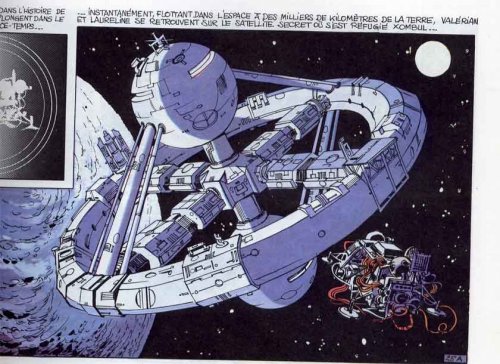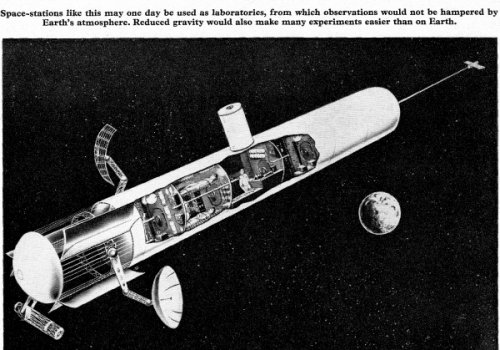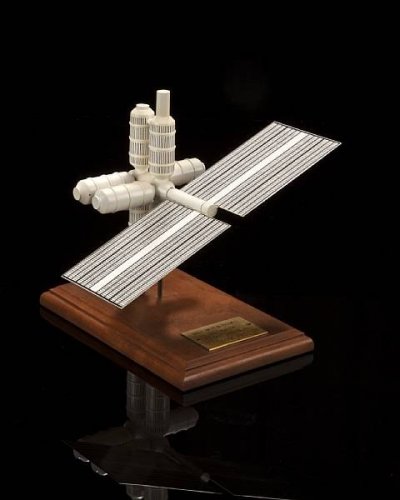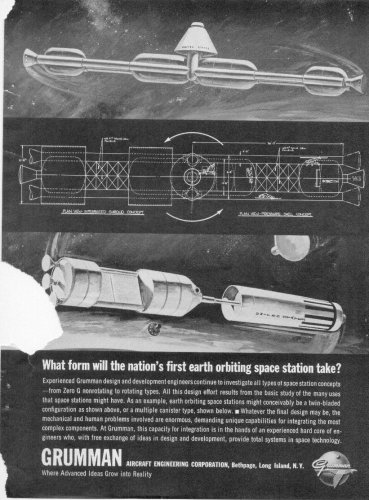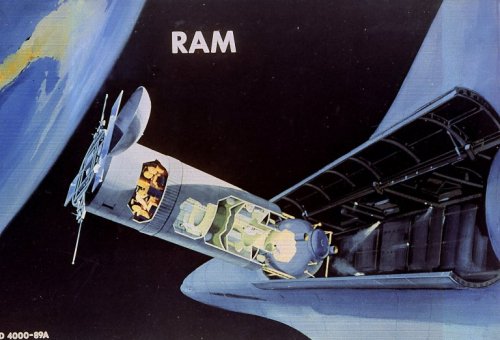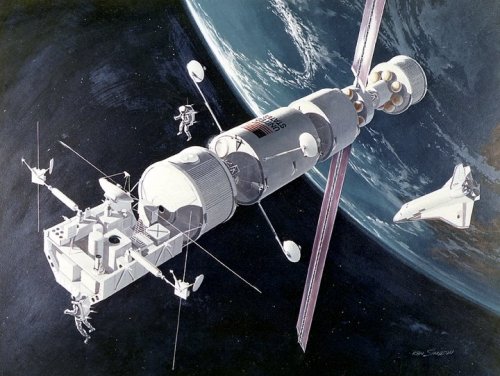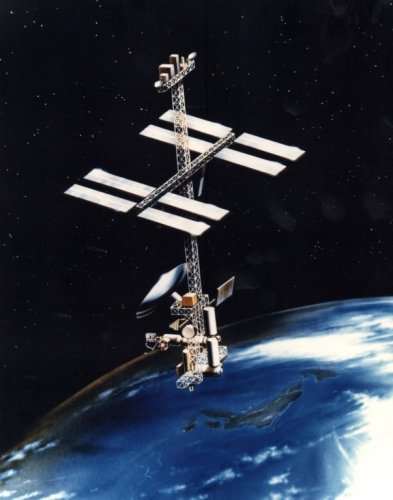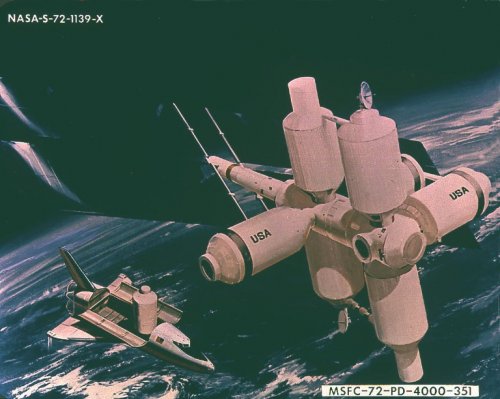You are using an out of date browser. It may not display this or other websites correctly.
You should upgrade or use an alternative browser.
You should upgrade or use an alternative browser.
Space Station Concepts
- Thread starter Barrington Bond
- Start date
There was a paper in the December 1991 issue of the Journal of the British Interplanetary Society by Michael A Minovitch of Phaser Telepropulsion Inc proposing the building of rotating 2001 type stations 100 metres diameter for at least 150 crew by using automatic wrapping machines rotating round inflated Kevlar torus’ to wind thin layers of aluminium until the required thickness had been made.
The rotating toroidal living section would have a major and minor radii of 100m and 2m while the two central column cylinders with labs etc and constructed in the same way would each be 100m long x 10m diameter. The two column cylinders would connect into a pre-fabricated central hub into which three spokes 100m long x 4m diameter also constructed in the same way would be fitted to join the hub to the toroidal living section.
The station also served as the basis for a 'cycling' ship and would take about 10 HLLV (assuming 100 tons/launch) or 14 Shuttle-C launches and 1 STS flight with minimal EVA.
Costs were about $400 billion for an Earth orbit station, a Mars orbit station and a cycling ship.
The rotating toroidal living section would have a major and minor radii of 100m and 2m while the two central column cylinders with labs etc and constructed in the same way would each be 100m long x 10m diameter. The two column cylinders would connect into a pre-fabricated central hub into which three spokes 100m long x 4m diameter also constructed in the same way would be fitted to join the hub to the toroidal living section.
The station also served as the basis for a 'cycling' ship and would take about 10 HLLV (assuming 100 tons/launch) or 14 Shuttle-C launches and 1 STS flight with minimal EVA.
Costs were about $400 billion for an Earth orbit station, a Mars orbit station and a cycling ship.
On the subject of the first pics (Goodyear inflatable thing of 1961)
More information available at NASA NTRS.
http://ntrs.nasa.gov/search.jsp?N=0&Ntk=all&Ntx=mode%20matchall&Ntt=inflatable%2Bstation%2B1961
(if that doesn't work, try "inflatable station+1961" on the search engine)
The man behind this goodyear inflatable also proposed a smaller module for Apollo X. There a scheme of it on the astronautix website.
http://www.astronautix.com/craft/apollox.htm
The men (they were two) Paul Hill and Emanuel "Manny" Schnitzer
How old was Robert Bigelow in the 60's ?
?
More information available at NASA NTRS.
http://ntrs.nasa.gov/search.jsp?N=0&Ntk=all&Ntx=mode%20matchall&Ntt=inflatable%2Bstation%2B1961
(if that doesn't work, try "inflatable station+1961" on the search engine)
The man behind this goodyear inflatable also proposed a smaller module for Apollo X. There a scheme of it on the astronautix website.
http://www.astronautix.com/craft/apollox.htm
The men (they were two) Paul Hill and Emanuel "Manny" Schnitzer
How old was Robert Bigelow in the 60's
OM
ACCESS: Top Secret
Archibald said:How old was Robert Bigelow in the 60's?
...Actually, the inflatable begs the following questions:
1) How would concepts from other tire manufacturers vary? In tread only?
2) Would the winning bid go to Discount Tire?
- Joined
- 13 August 2007
- Messages
- 7,880
- Reaction score
- 9,007
OM
ACCESS: Top Secret
Michel Van said:that Mini Space Station is HOPE
is this a Wet workshop MORL ?
picture found here
http://www.cloudster.com/RealHardware/SIVBStage/Models/ModelsTop.htm
...Note to Lowther: The station needs to be made into a kit the same scale as the Revellogram Gemini
Demon Lord Razgriz
ACCESS: Confidential
- Joined
- 31 October 2008
- Messages
- 188
- Reaction score
- 12
Wasn't there a design for a space station that would reuse the empty fuel tank?
I believe it was envisioned that 2 shuttle would launch shortly after the other. They would eject the SRB but keep the fuel tank attached to the shuttle until it reached high orbit, then detaching it and connect it to the second tank. After several repeat dual launched, the tanks would be connected into a ring and equipment would then be installed for people to use the new station.
Can anyone find a source on this as I can't remember where I heard this from.
I believe it was envisioned that 2 shuttle would launch shortly after the other. They would eject the SRB but keep the fuel tank attached to the shuttle until it reached high orbit, then detaching it and connect it to the second tank. After several repeat dual launched, the tanks would be connected into a ring and equipment would then be installed for people to use the new station.
Can anyone find a source on this as I can't remember where I heard this from.
- Joined
- 13 August 2007
- Messages
- 7,880
- Reaction score
- 9,007
something like this ?
STS External Tank Station
http://www.astronautix.com/craft/stsation.htm
PDF here
http://ntrs.nasa.gov/archive/nasa/casi.ntrs.nasa.gov/19940004970_1994004970.pdf
STS External Tank Station
http://www.astronautix.com/craft/stsation.htm
PDF here
http://ntrs.nasa.gov/archive/nasa/casi.ntrs.nasa.gov/19940004970_1994004970.pdf
XP67_Moonbat
ACCESS: Top Secret
- Joined
- 16 January 2008
- Messages
- 2,261
- Reaction score
- 461
Demon Lord,
Check out page 12 of this PowerPoint brief. Perhaps this is what you had in mind.
http://chapters.nss.org/ny/nyc/Shuttle-Derived%20Vehicles%20Modified.pdf
Moonbat
Check out page 12 of this PowerPoint brief. Perhaps this is what you had in mind.
http://chapters.nss.org/ny/nyc/Shuttle-Derived%20Vehicles%20Modified.pdf
Moonbat
Barrington Bond said:For all those one off types...
I'm a newbie here but I've always been partial to this design, looged somewhere as Skylab 2
Attachments
Demon Lord Razgriz
ACCESS: Confidential
- Joined
- 31 October 2008
- Messages
- 188
- Reaction score
- 12
Sorry guys, but that's not what I remember, though those are pretty cool. What I remember is that the tanks were connected in a ring, like the ones at the top.
- Joined
- 13 August 2007
- Messages
- 7,880
- Reaction score
- 9,007
Tomac said:I'm a newbie here but I've always been partial to this design, looged somewhere as Skylab 2
no that McDonnell Douglas Modular Station 1971
with Space Shuttle this kind of station became popular
http://www.astronautix.com/craft/modation.htm
- Joined
- 29 September 2006
- Messages
- 1,700
- Reaction score
- 1,182
Demon Lord Razgriz said:Sorry guys, but that's not what I remember, though those are pretty cool. What I remember is that the tanks were connected in a ring, like the ones at the top.
I remember one ring-form ET station. The tanks were aligned with their long axis parallel to the axis of rotation - it was a biiig station. Might have been one of those space-colonisation proposals that interest groups have been pushing since the 70s.
Michel Van said:no that McDonnell Douglas Modular Station 1971 with Space Shuttle this kind of station became popularTomac said:I'm a newbie here but I've always been partial to this design, looged somewhere as Skylab 2
http://www.astronautix.com/craft/modation.htm
Thanks for the link, I've been looking for further information on that design for a while.
- Joined
- 13 August 2007
- Messages
- 7,880
- Reaction score
- 9,007
starviking said:Demon Lord Razgriz said:Sorry guys, but that's not what I remember, though those are pretty cool. What I remember is that the tanks were connected in a ring, like the ones at the top.
I remember one ring-form ET station. The tanks were aligned with their long axis parallel to the axis of rotation - it was a biiig station. Might have been one of those space-colonisation proposals that interest groups have been pushing since the 70s.
One ?
must be over hundreds proposal like this since 1970 !
i have a question:
is this Space Station based on a real design ? (see Picture)
begin 1970 this pop-up in Marvel Comicbooks and this French Comicbook
Valerian, agent spatio-Temporel - La cite des eaux mouvantes
by J.C Mezieres (drawings) P. Christin (story) 1971
i know that Mezieres take allot real hardware in his drawings
Attachments
- Joined
- 29 September 2006
- Messages
- 1,700
- Reaction score
- 1,182
Michel Van said:i have a question:
is this Space Station based on a real design ? (see Picture)
I don't think so - the spherical sections at either end of the axis of rotation seem to be 'inspired' by the control section of 2001's Discovery spaceship.
Also, the connectors coing out from the rim of the station to each spherical section seem pretty superfluous to me - and 'superfluous' is not a word usually used to describe an actual design, IMHO.
- Joined
- 13 August 2007
- Messages
- 7,880
- Reaction score
- 9,007
starviking said:I don't think so - the spherical sections at either end of the axis of rotation seem to be 'inspired' by the control section of 2001's Discovery spaceship.
yes, Kubrick "2001" was a heavy influential to Mezieres work in 1970's (and rest of world)
the Marvel version was more Jack Kirby 'inspired'
see picture
starviking said:Also, the connectors coing out from the rim of the station to each spherical section seem pretty superfluous to me - and 'superfluous' is not a word usually used to describe an actual design, IMHO.
I think that the sphere were dockin port for shuttel
and the connectors are Elevators tube to ring
but can it be the original was not real Space Station proposal
but a Coverart on a Sci-fi Magazine ?
Attachments
Saturn S-IVB Advanced Station concept from McDonnell Douglas from the 1960s. Would this have been designated an Advanced Orbital Workshop (AOWS) station?
http://www.astronautix.com/craft/sivation.htm
http://www.astronautix.com/craft/sivation.htm
Attachments
OM
ACCESS: Top Secret
Michel Van said:but can it be the original was not real Space Station proposal but a Coverart on a Sci-fi Magazine ?
..."Drydock" from Marvel Comics Presents #12, the last of the 1st but short-lived "Guardians of the Galaxy" series. The time is about right, and ISTR artist Al Milgrom being somewhat of an astrobuff, which might explain the swipe.
starviking said:Demon Lord Razgriz said:Sorry guys, but that's not what I remember, though those are pretty cool. What I remember is that the tanks were connected in a ring, like the ones at the top.
I remember one ring-form ET station. The tanks were aligned with their long axis parallel to the axis of rotation - it was a biiig station. Might have been one of those space-colonisation proposals that interest groups have been pushing since the 70s.
Here's a link to the Space Island folks. The founder believed in linking the external tanks in a ring to create a space station (one of many ideas he had for using the external tank):
http://www.spaceislandgroup.com/home.html
Model of Rockwell Space Station proposal found at the Bonhams Auction House web site.
URL: http://www.bonhams.com/cgi-bin/public.sh/pubweb/publicSite.r?sContinent=USA&screen=lotdetailsNoFlash&iSaleItemNo=4570361&iSaleNo=17778&iSaleSectionNo=1
Description:
Added from “Found on Ebay” thread
URL: http://www.bonhams.com/cgi-bin/public.sh/pubweb/publicSite.r?sContinent=USA&screen=lotdetailsNoFlash&iSaleItemNo=4570361&iSaleNo=17778&iSaleSectionNo=1
Description:
Lot No: 1135
PROPOSED ROCKWELL SPACE STATION.
Model of an early earth orbiting space station 6 inches tall and 3 inches wide made from wood and metal. Displayed on an 8 by 5½ inch wood base with a plaque that reads: "North American Rockwell Space Division Space Station 1/200 scale." The seven 2½ by 1 inch cylinder type modules are attached to a central core with a 10 by 3½ inch movable (and removable) solar panel array.
Several proposals throughout the late 1960s and 1970s were developed to create a permanently manned space station. North American Rockwell was aggressive in proposing a space station to keep their talented work force together as the Apollo Program funding was ending. A Nixon Administration decision to fund either a Space Station or Space Shuttle, but not both, was given to the space agency. NASA chose to develop a space shuttle, with Rockwell winning the contract. This space station design never had the funding to be developed. Presented to Dr. Faget.
Estimate: $1,500 - 2,000
Added from “Found on Ebay” thread
Attachments
FutureSpaceTourist
ACCESS: Top Secret
- Joined
- 10 March 2010
- Messages
- 589
- Reaction score
- 30
It's mentioned elsewhere on the site, but I think it's worth repeating here that Marcus Lindroos has started a space station site http://sites.google.com/site/spaceodysseytwo/Home/space-stations-and-manned-spaceflight-in-the-1980s-and-90s. So far it only has a Boeing Space Operations Center concept. Hopefully he'll have time to develop it further.
- Joined
- 13 August 2007
- Messages
- 7,880
- Reaction score
- 9,007
Barrington Bond said:From "Eagle Book Of Rockets And Space Travel" 1961 by John W R Taylor and Maurice Allward.
Any ideas for which companies these belong to?
if that Earth in background
then they are Clark Station in geostationary earth orbit
odd the text tell about artificial gravity, but the graphic not.
- Joined
- 14 June 2006
- Messages
- 2,297
- Reaction score
- 487
Drydock's station has some similarity with one of the concepts for an External Tank based habitat from 1977 (i.e. minus the two big spheres). And BTW, see attached for a near-KO shot.. ;D This comes from:
Design of the Space Station Habitable Modules
By Gary H. Kitmacher
53rd International Astronautical Congress
The World Space Congress - 2002
10-19 October 2002/Houston, Texas
If someone is interested in hi-res (300 dpi), PM me.
Design of the Space Station Habitable Modules
By Gary H. Kitmacher
53rd International Astronautical Congress
The World Space Congress - 2002
10-19 October 2002/Houston, Texas
If someone is interested in hi-res (300 dpi), PM me.
Attachments
Hi Skybolt,
I am very interested by this poster about Space stations (I don't know if is it still available - where ?). However, I will be happy to receive a high resolution version on my webmail.
Thanks,
Best Regards,
XB-35
I am very interested by this poster about Space stations (I don't know if is it still available - where ?). However, I will be happy to receive a high resolution version on my webmail.
Thanks,
Best Regards,
XB-35
FutureSpaceTourist
ACCESS: Top Secret
- Joined
- 10 March 2010
- Messages
- 589
- Reaction score
- 30
Skybolt said:This comes from:
Design of the Space Station Habitable Modules
By Gary H. Kitmacher
There's a 2.5MB PDF scanned version at http://www.spacearchitect.org/pubs/IAC-02-IAA.8.2.04.pdf. Quality isn't great, but is readable.
FutureSpaceTourist said:Skybolt said:This comes from:
Design of the Space Station Habitable Modules
By Gary H. Kitmacher
There's a 2.5MB PDF scanned version at http://www.spacearchitect.org/pubs/IAC-02-IAA.8.2.04.pdf. Quality isn't great, but is readable.
Great document, notably the part on Skylab. Thank you all !
- Joined
- 1 November 2009
- Messages
- 638
- Reaction score
- 410
Artist's impression of General Dynamics Convair Aerospace Research and Applications Modules from 1971.
From NASA Images:
Source: http://www.nasaimages.org/luna/servlet/detail/nasaNAS~9~9~58278~162122:
From NASA Images:
This is an artist's concept of the Research and Applications Modules (RAM). Evolutionary growth was an important consideration in space station planing, and another project was undertaken in 1971 to facilitate such growth. The RAM study, conducted through a Marshall Space Flight Center contract with General Dynamics Convair Aerospace, resulted in the conceptualization of a series of RAM payload carrier-sortie laboratories, pallets, free-fliers, and payload and support modules. The study considered two basic manned systems. The first would use RAM hardware for sortie mission, where laboratories were carried into space and remained attached to the Shuttle for operational periods up to 7 days. The second envisioned a modular space station capability that could be evolved by mating RAM modules to the space station core configuration. The RAM hardware was to be built by Europeans, thus fostering international participation in the space program.
Source: http://www.nasaimages.org/luna/servlet/detail/nasaNAS~9~9~58278~162122:
Attachments
Artist's impression of McDonnell Douglas Manned Orbital Systems Concept (MOSC) from 1975.
From NASA Images:
Source: http://www.nasaimages.org
From NASA Images:
Despite the indefinite postponement of the Space Station in 1972, Marshall Space Flight Center (MSFC) continued to look to the future for some type of orbital facility during the post-Skylab years. In 1975, the MSFC directed a contract with the McDonnell Douglas Aerospace Company for the Manned Orbital Systems Concept (MOSC) study. This 9-month effort examined the requirements for, and defined a cost-effective orbital facility concept capable of, supporting extended manned missions in Earth orbit. The capabilities of this concept exceeded those envisioned for the Space Shuttle and Spacelab, both of which were limited by a 7 to 30-day orbital time constraint. The MOSC's initial operating capability was to be achieved in late 1984. A crew of four would man a four-module configuration. During its five-year orbital life the MOSC would have the capability to evolve into a larger 12-to-24-man facility. This is an artist's concept.
Source: http://www.nasaimages.org
Attachments
Artist's impression of NASA Langley Research Center space station concept from 1962.
From NASA Images:
Source: http://www.nasaimages.org
From NASA Images:
Artist's concept of possible manned space station. One of Langley's early concepts for a manned space station: a self-inflating 75-foot-diameter rotating hexagon.
Source: http://www.nasaimages.org
Attachments
Artist's impression of "Power Tower" space station concept from 1985.
From NASA Images:
Source: http://www.nasaimages.org
From NASA Images:
This is an artist's conception of the proposed "Power Tower" space station configuration, shown with the Japanese Experiment Module attached. This model and several others were examined before deciding on the Space Station Freedom structure that was later abandoned in favor of the International Space Station.
Source: http://www.nasaimages.org
Attachments
Artist's impression of a modular space station from 1972.
From NASA Images:
Source: http://www.nasaimages.org
From NASA Images:
This is an artist's concept of a modular space station. In 1970 the Marshall Space Flight Center announced the completion of a study concerning a modular space station that could be launched by the planned-for reusable Space Shuttle. The study envisioned a space station composed of cylindrical sections 14 feet in diameter and of varying lengths joined to form any one of a number of possible shapes. The sections were restricted to 14 feet in diameter and 58 feet in length to be consistent with a shuttle cargo bay size of 15 by 60 feet. Center officials said that the first elements of the space station could be in orbit by about 1978 and could be manned by three or six men. This would be an interim space station with sections that could be added later to form a full 12-man station by the early 1980s.
Source: http://www.nasaimages.org
Attachments
Similar threads
-
Orbital Technologies commercial space station
- Started by FutureSpaceTourist
- Replies: 6
-
-
-
Stealing secrets from the ether: missile and satellite telemetry interception during the Cold War
- Started by Flyaway
- Replies: 4
-

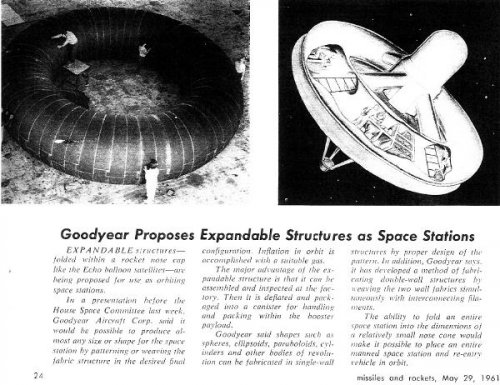

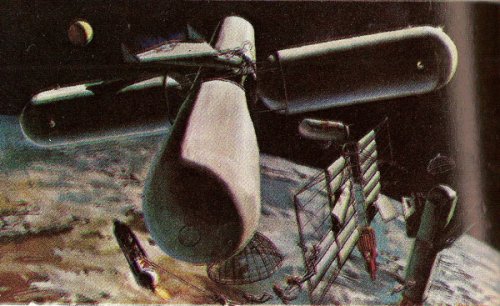


![(1995) [Space Station] NASA 'Skylab 2' (01).jpg](/data/attachments/23/23550-cc80a186602d3b271ab7d2e2b7a8982d.jpg)
